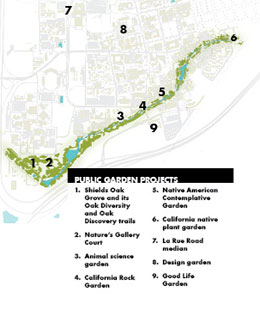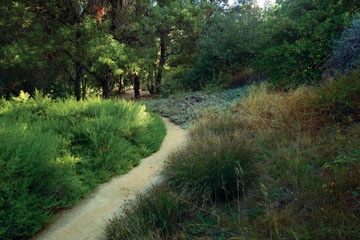Volume 29 · Number 4 · Summer 2012
Outside the box
Photos by Karin Higgins and Gregory Urquiaga/UC Davis, produced by Dave Jones, UC Davis
Download: Adobe Flash (free)
UC Davis, UC Davis how does your garden grow? And by garden we mean the arboretum and other landscapes around the central campus. Today they are in sync, growing in stature and sustainability as a public garden unlike any other at a university.
Since UC Davis launched its Public Garden Initiative in June 2011, the arboretum and academia have been collaborating more than ever before, stretching their missions and overlapping boundaries to create new opportunities in teaching and research, develop new landscapes, and boost community engagement.
The 75-year-old arboretum has long been a laboratory for teaching, learning and research. Now, as part of our public garden, the arboretum is bringing discipline-themed gardens to faculty and students all over campus.
"This is a transformative moment in the history of the campus," Peter H. Raven, famed botanist and conservationist, said during a visit to UC Davis in January. "This is not about a garden branching out. Think of it as a rededication of the campus to the principles of sustainable horticulture, the environment and academics."
Public Garden Management (2011), the first textbook in the field, describes a public garden as a living museum, a place of learning, with plant collections and infrastructure, and a staff to manage those elements and use them to further the garden's mission.
UC Davis qualifies on all counts, said Assistant Vice Chancellor Kathleen Socolofsky, the arboretum director. "We take all three elements of the university's mission — teaching, research and public service — and integrate them," she said.
Thus we have the California Rock Garden, almost completed, featuring nearly 50 boulders around the Earth and Physical Sciences Building; and, across campus, the design garden that is in the works for the courtyard of Cruess Hall, the new home of the Department of Design. This garden will be a showcase, say, for designs that put discarded goods to new uses.
Socolofsky said faculty, staff and alumni involvement in the garden design process leads to continued involvement — in planting and maintaining the gardens, and, in the case of geology, finding the right boulders and arranging to have the 500- to 6,500-pound rocks hauled to the campus. "Our departments are really taking ownership," she said.
Volunteers are taking ownership, too, digging and planting and building as they do all over the arboretum. Gifts and grants are also helping. For example, the state recently awarded nearly $900,000 in bond money for "urban greening" where the arboretum connects with downtown Davis.
Visitor-friendly storytelling

Wherever you may come across a garden, the goal is the same, to pique people's interest in the UC Davis mission, in what goes on beyond the gardens and inside the buildings.
"We are telling the UC Davis story in a visitor-friendly way," said Socolofsky, who leads the UC Davis Public Garden Initiative with Bob Segar, assistant vice chancellor for Campus Planning and Community Resources. The initiative incorporates the nearly 5-year-old GATEways Project (GATE stands for Gardens, Art and The Environment), which grew in concert with the conversion of UC Davis' south entry to the campus's new front door.
Public gardens are not new, but none has been so tightly connected to the university enterprise — until now. This, Raven said, gives the UC Davis project "the ability to celebrate the merging or common interest of the basic sciences, environmental sciences, agriculture, horticulture, medicine, arts and sciences, and all aspects of human culture that are both pleasing and important to the development of the community at large."
'A modern garden of Eden'
While the arboretum gave root to the UC Davis public garden, campus officials are quick to point out that they are not turning the whole campus into the arboretum. "We're taking what the arboretum does so well — in community engagement, programming and sustainability — and bringing it to the rest of the campus landscape," Segar said.
The sustainability effort can be seen at the arboretum's far west end, where the turf has given way to a meadow of native grass; and in the La Rue Road median, where the turf is being replaced with drought-tolerant plants. Other water- and maintenance-intensive landscapes around the campus will get similar makeovers.
"Using the campus as a model, this could be a modern garden of Eden that will allow us to live in harmony with the Earth," Raven said during his campus visit. "It would be sustainable in every respect."

